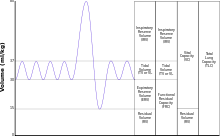- Respiratory minute volume
-
TLC Total lung capacity: the volume in the lungs at maximal inflation RV Residual volume: the volume of air remaining in the lungs after a maximal exhalation ERV Expiratory reserve volume: the maximal volume of air that can be exhaled from the end-expiratory position IRV Inspiratory reserve volume: the maximal volume that can be inhaled from the end-inspiratory level IC Inspiratory capacity: the sum of IRV and TV IVC Inspiratory vital capacity: the maximum volume of air inhaled from the point of maximum expiration VC Vital capacity: the volume equal to TLC − RV VT Tidal volume: that volume of air moved into or out of the lungs during quiet breathing (VT indicates a subdivision of the lung; when tidal volume is precisely measured, as in gas exchange calculation, the symbol VT or VT is used.) FRC Functional residual capacity: the volume in the lungs at the end-expiratory position RV/TLC% Residual volume expressed as percent of TLC VA Alveolar gas volume VL Actual volume of the lung including the volume of the conducting airway. FVC Forced vital capacity: the determination of the vital capacity from a maximally forced expiratory effort FEV1 Volume that has been exhaled at the end of the first second of forced expiration FEFx Forced expiratory flow related to some portion of the FVC curve; modifiers refer to amount of FVC already exhaled FEFmax The maximum instantaneous flow achieved during a FVC maneuver FIF Forced inspiratory flow: (Specific measurement of the forced inspiratory curve is denoted by nomenclature analogous to that for the forced expiratory curve. For example, maximum inspiratory flow is denoted FIFmax. Unless otherwise specified, volume qualifiers indicate the volume inspired from RV at the point of measurement.) PEF The highest forced expiratory flow measured with a peak flow meter MVV Maximal voluntary ventilation: volume of air expired in a specified period during repetitive maximal effort Respiratory minute volume (or minute ventilation, or flow of gas) is the volume of air inhaled (inhaled minute volume) or exhaled (exhaled minute volume) from a person's lungs in one minute. This is normally registered when a person has a ventilator supporting the person's breathing due to a sickness or injury.
Minute volume is calculated by taking the tidal volume and multiplying it by the respiratory rate (the number of breaths per minute a person is taking). The higher the minute volume the more carbon dioxide (CO2) the person is releasing, the converse is the lower the minute volume the lower the amount of carbon dioxide the person is releasing.[citation needed]
A normal minute volume while resting is about 5–8 liters per minute in humans.[citation needed] Hyperventilation is the term for having a minute ventilation higher than physiologically appropriate.
The symbol used to represent minute volume is
 or MV.
or MV.Tidal Volume x Respiratory Rate = Minute Volume
A person requires a minimum of 6 to 8 litres of minute volume for the proper oxygenation of the tissues and the removal of carbon dioxide from the lungs. The minute volume increases at times of stress and exercise. During light activities minute volume may be around 12 litres per minute. Driving a bicycle increases minute ventilation by a factor of 2 to 4 depending on the level of exercise involved. Minute ventilation during moderate exercise may be between 40 and 60 litres per minute.[1] [2]
Relationship to other physiological rates
Minute volume comprises the sum of alveolar ventilation and dead space ventilation. That is:

where
 is alveolar ventilation, and
is alveolar ventilation, and  represents dead space ventilation.
represents dead space ventilation.References
- ^ Zuurbier, M., Hoek, G., van den Hazel, P., Brunekreef, B. (2009). "Minute ventilation of cyclists, car and bus passengers: an experimental study.". Environmental Health 8 (48). http://www.ehjournal.net/content/8/1/48.
- ^ Int Panis, L (2010). "Exposure to particulate matter in traffic: A comparison of cyclists and car passengers". Atmospheric Environment 44: 2263–2270. doi:10.1016/j.atmosenv.2010.04.028.
External links
- Overview at healthsystem.virginia.edu
- Overview at ccmtutorials.com
- Physiology at MCG 4/4ch3/s4ch3_15
- What is minute ventilation
Categories:
Wikimedia Foundation. 2010.

